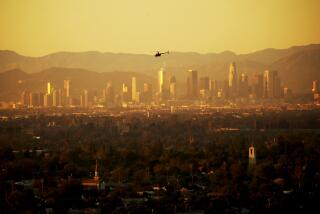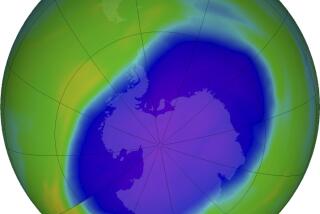Ozone Levels Over U.S. Drop to New Lows
In yet another ominous portent for the ozone layer, government scientists report today that the stratospheric shield that protects life from harmful ultraviolet radiation has plummeted to unexpected new lows over the Northern Hemisphere, including the United States.
The researchers, who reported their findings in today’s issue of Science, said the 1991 eruption of Mt. Pinatubo in the Philippines released tiny particles, or aerosols, that may have interacted with industry-produced gases to speed the ozone layer’s destruction. The eruption also may have triggered changes in high-altitude winds that accelerated the damage.
The losses, which are expected to persist into summer, include an average drop of 12% in ozone over the mid-latitudes where most Americans, Canadians and Europeans live and a dip of 15% over the West Coast, including California. Stratospheric ozone is down by as much as 20% over Northern Canada, Greenland, Norway, parts of Alaska and Siberia, the scientists reported.
Scientists had expected ozone levels to plunge during the months after Mt. Pinatubo’s eruption but believed the volcano’s effects would have subsided by now.
Instead, the loss of ozone immediately after the eruption was largely limited to areas near the Equator, and the most dramatic effects are occurring now.
“That is what really astonished everybody,” said Paul Newman, an atmospheric physicist at NASA’s Goddard Space Flight Center in Maryland and a co-author of the report.
The scientists’ findings are based on an analysis of ozone measurements from the Total Ozone Mapping Spectrometer (TOMS) on board NASA’s Nimbus-7 satellite, which was launched in late 1978. The results were confirmed by other space-based measuring instruments.
Newman said the loss over the United States and other mid-latitude countries could cause about a 16% increase in harmful ultraviolet radiation this summer, reducing the amount of time it takes for skin to burn in the sun.
“I am certainly going to be a little stricter about the kids going out in the sun this year,” Newman said, “but it’s not a panic situation.”
He noted that urban smog, unhealthful for other reasons, will screen out some of the harmful ultraviolet radiation in such cities as Los Angeles. “It’s sort of borrowing from Peter to pay Paul,” he said.
Because ozone in the upper atmosphere absorbs the sun’s ultraviolet radiation, its loss is expected to increase skin cancer, cause cataracts, possibly interfere with the human immune system and reduce crop yields.
Scientists say industry gases are triggering a 2.7% decrease in global ozone each decade. The gases, chlorofluorocarbons or CFCs, were previously used as aerosol propellants and continue to be used as coolants and in making plastic.
Even though CFCs are being phased out throughout much of the world, they are long-lived and inflict damage decades after they have been emitted. The depletion from industrial gases today is a result of CFCs released during the late 1980s.
“We have the measurements, and the ozone is really going down,” said Richard McPeters, another NASA scientist and co-author of the report. “And this is continuing and we expect it to continue until all of the (man-made gases) in the atmosphere are cleaned up sometime in the next century. But in the meantime, we are seeing something that is really unusual”--the plunge in current levels.
How big a role man-made emissions are playing in the current episode of ozone loss is unclear “because we don’t completely understand how volcanic dust would have changed the ozone level without the industrial gases,” said Mark Schoeberl, head of the Goddard center’s atmospheric chemistry and dynamics branch.
Though the scientists strongly suspect that Pinatubo accelerated the ozone damage, “we still have a lot of work to do to really pin down what has happened,” Newman said.
McPeters described researchers as “a long way from being certain” in attributing the plunge to Mt. Pinatubo.
“It looks like a really good guess,” he said, “but there is always a possibility we are wrong. When the Antarctic ozone hole showed up, nobody had predicted it.”
The total average global ozone measured in late 1992 and early 1993 was 2% to 3% lower than any previous year and 4% lower than the average level from 1980 to 1990.
The researchers believe ozone levels will begin to creep back up over the Northern Hemisphere in the fall and winter, when levels traditionally rise, and possibly return to more normal levels when the aerosols released by Pinatubo dissipate in a year or two.
Stratospheric winds already have largely cleansed the world’s tropics from the fallout of Pinatubo, and stratospheric ozone has returned to normal and even above normal levels. The tropics experienced their most severe ozone loss immediately after the eruption. The winds have since carried the volcanic aerosols into the Northern Hemisphere. Average ozone levels in the Southern Hemisphere remain low but not outside their historic range, Newman said.
Also adding to the ozone debate were unusually cold temperatures this past winter in the Arctic, which, when combined with sunlight, activated chlorine from industrial gases into a destructive form and reduced Arctic ozone levels. This may have exacerbated ozone loss in the rest of the Northern Hemisphere, said Joe Waters, a NASA scientist who wrote a recent report on global levels of the destructive form of chlorine.
“Part of the problem (for global levels) is that the volcano may have increased the dangers of the man-made chlorine,” said Waters, a senior research scientist at NASA’s Jet Propulsion Laboratory. “But the volcano would not have been a problem had there not already been chlorine in the stratosphere.”






